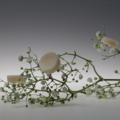Understanding the nanostructure formation in block copolymer thin film

The paper “Understanding nanodomain morphology formation in dip-coated PS-b-PEO thin films” was published in the September issue of Nanoscale Advances (Volume 3, Issue 17).
The research work for the manuscript was conducted under the SUPER-WEAR project (Super-stretchable functionalized materials and fibers for third generation wearable technology) funded by the Academy of Finland and led by Prof. Jaana Vapaavuori.
All experiments were performed by Hoang M. Nguyen, and the TEM analysis was done by Swarnalok De. The development of the theory was a joint effort of both Hoang M. Nguyen and Ariane V. Mader.
Hoang M. Nguyen about the publication: "Block copolymer (BCP) thin films prepared by dip-coating are increasingly investigated, owing to the many promising application areas, the facility, and the industrial scalability of this technique. Yet, the effect of different dip-coating parameters on BCP nanostructure formation is still underdeveloped and the results of previous literature are limited to a few block copolymers. Here, we study the effect of the withdrawal rate and solvent selectivity on the morphology evolution of dip-coated polystyrene-b-poly(ethylene oxide) thin films by applying a wide range of dip-coating speeds and altering the volume ratio of the tetrahydrofuran–water solvent system. Notably, we have obtained a hexagonally packed BCP pattern with long-range order without the need for post-annealing processes."
Link to the publication: https://doi.org/10.1039/D1NA00263E
Keywords: block copolymer, dip-coating, PS-b-PEO, self-assembly
Related content:
Multifunctional Materials Design
Group led by Professor Jaana Vapaavuori

SUPER-WEAR project
Super-stretchable functionalized materials and fibers for third generation wearable technology

- Published:
- Updated:
Read more news

What makes nature restorative? Aalto University researchers explore Finnish forests and Japanese gardens
Biodiversity is central to the restorative power of Finnish forests.
New technology brings immersive audio to everyone’s pockets
A new type of sound recording technology allows recording of immersive soundscapes with ordinary microphones and an inexpensive accessory
Funding for a democratic transition to sustainability
Three projects from Aalto University are among the recipients. The Nessling Foundation's grants aim to advance the implementation of sustainability transitions in the context of democracy, the EU, and nature conservation areas.